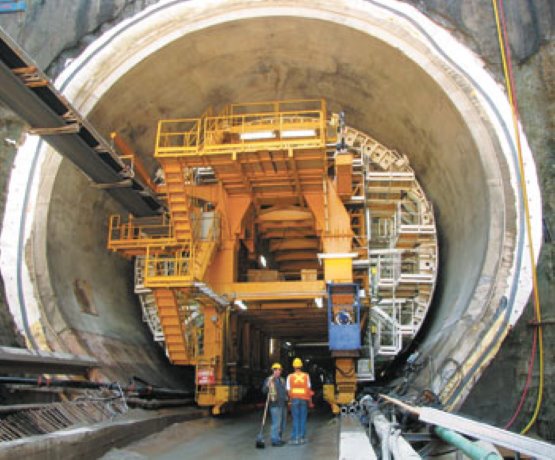A special waterproof membrane, an unreinforced concrete liner, an on-site batching plant and concrete delivery truck trailers with hitches on both ends are just some of the elements of one the largest tunnel operations underway in North America at the Niagara Tunnel.
A special waterproof membrane, an unreinforced concrete liner, an on-site batching plant and concrete delivery truck trailers with hitches on both ends are just some of the elements of one the largest tunnel operations underway in North America.
The 10.2-kilometre-long, 12.7-metre diameter, 14.4-metre-high Niagara Tunnel will deliver additional water from above Niagara Falls to increase capacity of Ontario Power Generation’s (OPG) Sir Adam Beck stations in Queenston.
Excavation of the tunnel by Big Becky, the world’s largest Tunnel Boring Machine (TBM) with a 14.44-metre-diameter drill profile, has been underway since 2006 and is scheduled for completion this April.
But the overall tunnel project, including the substantial concrete work, won’t be completed until 2013, said OPG officials.
Early in the project, Strabag Inc., the Vienna-based design/build contractor, constructed an on-site batch plant to make the copious amounts of concrete that have and are being consumed in the construction of the 600-mm-thick unreinforced concrete liner.
The liner is thinner than normally might have been the case in a project of this magnitude and doesn’t require reinforcing steel through the use of a polyolelfin waterproofing membrane, said Rick Everdell, OPG’s Niagara Tunnel project director.
“Use of this type of waterproof membrane is rare in North America, but it is used in many railway and highway tunnels in Europe,” said Everdell, explaining Strabag recommended it as part of its successful bid on the project.
As the machine pushes ahead with the excavation, an initial supporting system comprised of steel ribs, wire mesh and rock bolts, and a full ring of shotcrete is applied.
The membrane is applied after the shotcrete and before the liner.
Unlike other applications where waterproofing is used to prevent water seeping into a structure or pipe, this membrane is designed to keep the water from leaking out, he explained.
“It prevents the fresh water flowing through the tunnel from leaking into the surrounding rock and displacing the super-saturated salt water trapped in the rock,” he said.
“If that were to occur, the rock around the tunnel, in particular, the clay minerals in the (local) Queenston shale, would swell and could potentially put the liner under a great deal of stress.”
The liner is comprised of an invert or bottom section and the arch, which is the top two thirds, said Everdell, who uses the analogy of a clock to explain their positioning.
“The invert is the area from four to eight and the arch is the area from eight to four,” he said.
An invert lining station is used to install the invert.
This is being done through the use of two 12.5-metre long forms operating in a leapfrog sequence.
“So by the end of the day 25 metres of invert lining has been placed,” he said.
Trailing behind the lining station is the 1,800-ton, 450-foot long arch installation carrier, which also installs about 25 metres of concrete per day.
At this point, about 6,850 metres of the invert and 1,900 metres of the arch have been installed, said Strabag project manager Ernst Gschnitzer.
Concrete is delivered to the two machines from the on-site batch plant by specially designed delivery trailers.
Once the concrete has been delivered, the driver can unhitch his cab, turn around, drive to the opposite end of the trailer, hook up and then drive back the same way he came in.
“We have passing and turning lanes,” said Gschnitzer, in explaining how the trucks manoeuvre around workers and equipment completing other phases of the project.
Designed for a 100-year life span, the tunnel will generate enough clean renewable energy to power 160,000 homes a year when it’s operational in 2013, said Everdell.











Recent Comments
comments for this post are closed